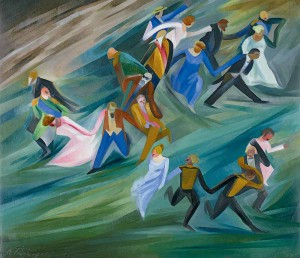The latter half of the 20th century in Russia saw this idiom become a cultural space for so-called “internal emigre.s”. Art allowed them not only the possibility of free thinking, but the prospect of actually feeling themselves to be human. There was never enough of this language to go around, and it suffered collapse and ruin, similar to the language of Yerofeyev’s texts that collides with its antithesis or antilanguage and experiences a breakdown of all existing relations and former foundations.
At that time, contemporary artists took as read that the official culture was an environment in which art simply could not exist. The idiom of art became an antibody to this culture. Artists began experimenting with all the cultural spaces that contained meanings rejected by the establishment – obscurantism, religion, pathologies, illnesses, alcoholism, drug abuse, the criminal world, etc.
This was the cultural space in which the names of Vladimir Pyatnitsky, Anatoly Zverev, Vladimir Yakovlev, Edward Kurochkin and Marlen Shpindler played an important role. This was the zone in which George Schetinin conducted his striking experiment of drawing endless pictures, all inspired by the poetry of Francois Villon, for an entire fifty years, as there existed only a single text, history, language, out of which the black-and-white dynamic of a twodimensional world kept growing and expanding. This is neither metaphor nor hyperbole; there is nothing else, just as Bulgakov wrote, “There is nothing, and was never anything! There’s that wilted linden tree, there’s the iron grating, and beyond it, the street … The ice is melting in the vase, and I see someone’s bloodshot eyes at the desk nearby. The horror, the horror of it all … O gods! O gods of mine! Bring me poison, poison!” [21]
Whenever the artist makes an appearance in the zone of communal culture, this means that he has stopped taking into account the boundary that had previously divided the world of his art work from the cultural space of everyday reality. This is a single, lengthy transition, and the artist hears whispered advice to continue on this journey coming from the image of the traveller, the homeless wanderer, the hobo, or the medieval leper, who is always going away, decomposing, and frightening passers-by.
The figure of the outcast or pariah is attractive against the unpleasant background of “contemporary culture”. It matters not whether this culture is Soviet or post-Soviet, whether it is clericalized or criminalized. What is important is that this culture is adapted and ready to be mass-consumed; it is safe and always protects itself. Art takes the form of disability, degradation and dying, and thereby anticipates the
official culture, which is waiting for all art that refuses to participate in the establishment’s staged experiments to degenerate and die.
When the establishment appoints a time and place for meeting the artist, he is falls into a stupor. He completely loses his faculty of concentration and becomes utterly incompetent to perform even the smallest tasks that communal culture charges him with. “I’ll simply stay down below in order to spit on your public staircase. Yes, that’s right. I’ll just hawk up on every step,” as Yerofeyev aptly puts it. [22] This is also what the entire culture of 20th century Russia says right along with him when it leaves the cultural space of history behind.




Капитановский Александр
25 Aug 2012
Встретил Ваши тексты, прежде не довелось. Теперь читаю. С благодарностью и уважением.